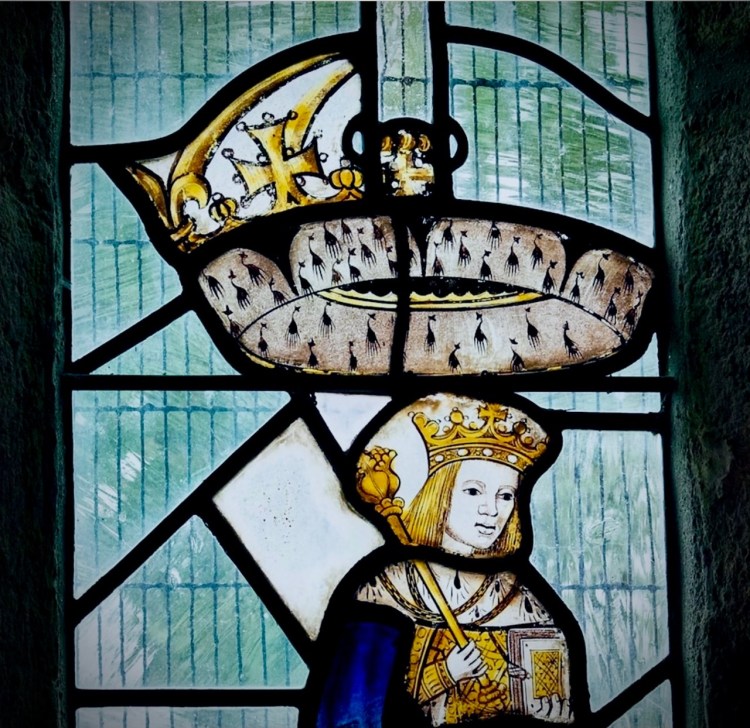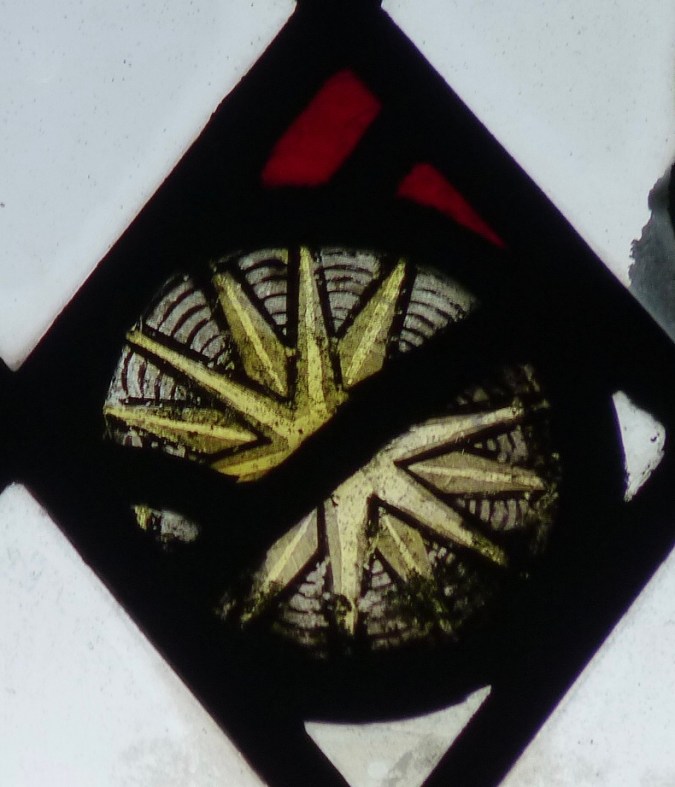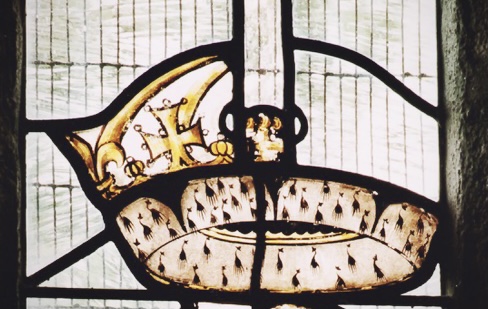
Stained glass image of Edward V in the Evans chapel at Coldridge Church. Image has been verified as being of Edward V by stained glass experts Brooks and Cherry as well as the Keeper of Ceramics at the Victoria and Albert Museum. Photo Photo Dale Cherry
Here is a link to an interesting article in the Telegraph. For those unable to access the article it’s also available on Yahoo News. Following my posts – A Portrait of Edward V and Perhaps Even a Resting Place – St Matthew’s Church Coldridge and a guest post – A PORTRAIT OF EDWARD V AND THE MYSTERY OF COLDRIDGE CHURCH Part II – by John Dike a Coldridge resident and who has been leading Philippa Langley’s The Missing Princes Project team in Devon, I am very happy to see this very plausible theory getting the publicity it deserves. Bill Gardner is Deputy News Editor of the Telegraph, and whose interest first being piqued by the Missing Princes Project, decided to have a catchup and recently travelled down to Coldridge to interview John Dike and to take a look around the church. The resultant article was published in the Telegraph on the 29 December 2021. I think its exciting and hopefully an indication that this theory – which is up to now one of the most plausible – of what became of one of the sons of Edward IV will become more widely known about and a refreshing antidote to the relentless, tedious and monotonous stories that the ‘Princes in the Tower’ were murdered.
A reminder of some of the clues in Coldridge Church : 
Yorkist emblems. Here a White Rose of York and a Sunne in Splendour.. Photo Dale Cherry

Sunne in Splendour effigy. Photo John Dike.

The open crown above the image of Edward V but which originally would have been in a different window – possibly the Chantry over a royal coat of arms. Note the deer in the ermine instead of the usual stoats tails. Surely a nod to John Evans as Parker at Coldridge Deer Park?

St Matthews Church, Coldridge beneath a glowering Devon sky. Could this be the burial place of John Evans who possibly was Edward V, son of Edward IV who lived out his life incognito in Coldridge.
Footnote. Another thought is that Edward V could have been present at the Battle of Stoke 16th June 1487. A young lad had been crowned King Edward in Dublin on the 24th May 1487 by die hard Yorkists. This ‘King Edward’ was found after the battle but the heralds recorded that although the young King Edward was taken, his real name was ‘John’ ‘And there was taken the lade that his rebelles called King Edwarde (whoos name was in dede John) – by a vaylent and a gentil esquire of the kings howse called Robert Bellingham’ (1). Is it possible that this ‘John’ was John Evans of Coldridge who in actual fact was Edward V. Is it also possible that this young man was badly wounded especially around the face, or even had his face purposefully disfigured and then returned to live out his life in Coldridge? This would explain why the face of the older man in the window at Coldridge appears to be badly scarred?

The face in the window of the mature man who appears to be scarred around the mouth and an opaque eye. Carries a crown and wearing ermine. Could this be John Evans – who in his life as Edward V was wounded at the Battle of Stoke?
- Chroniques de Jean Molinet ed. G Doutrepont and O Jordogne Brussells 1935. Translation taken from Michael Bennett’s Lambert Simnel and the Battle of Stoke. See also Heralds’Memoir 1486-1490 pp.116-17 E. Cavell.
Links to other posts with links to Coldridge.
1. THE MYSTERIOUS DUBLIN KING AND THE BATTLE OF STOKE
2. MARKENFIELD HALL & THE MARKENFIELD BROTHERS, THOMAS AND ROBERT
3. A PORTRAIT OF EDWARD V AND THE MYSTERY OF COLDRIDGE CHURCH…Part II A Guest Post by John Dike.
4. A Portrait of Edward V and Perhaps Even a Resting Place?- St Matthew’s Church Coldridge
5. PERKIN WARBECK AND THE ASSAULTS ON THE GATES OF EXETER
6. Lady Katherine Gordon – Wife to Perkin Warbeck
I’m really sorry to be a wet blanket, and I know this will not make me popular, but I feel I have to put the case for the opposition. Iam not going to dispute the identification of the king in the window as Edward V, but I would strongly question the assumption (and that is what it seems to me to be) that his image, and the other glass with Yorkist imagery, was put in and paid for by John Evans.
Coldridge was part of the inheritance of Cecily Bonville, who married Edward V’s half-brother, the Marquess Dorset.In her widowhood she lived in Devon and spent a fortune on improvements to the churches on her manors there. The Yorkist and EV imagery is surely far more likely to have been the work of either Dorset (extolling the memory of his royal brother) or his widow. Apparently Cecily was very proud of her York royal connections and even asked to be buried either beside Elizabeth of York in Westminster Abbey or in St. George’s Chapel, Windsor, rather than by Dorset – she did not get her way but that was her wish.
Also, there may be at least one other stained-glass image of Edward V in a SW-English parish church, and that is in Fairford in Gloucestershire, where it has been suggested that various Old Testament figures have been modelled on contemporary royals, and King Solomon is shown rather incongruously as a blond boy:
https://sparkypus.com/2021/01/29/st-marys-church-fairford-royal-portraits/
Do we know that glass and the Evans chantry originally had any connection with each other?To my eye the whole window looks to have been reformed from damaged pieces, and given the status of the royal imagery probably originally sat in the great east window, which now has only plain glass (so far as I can see from images online), but which must once have had the best stained glass in the house.
Is there not also a possibility that John Evans’ family took over an existing chantry chapel for his tomb, or that his tomb was moved into said existing chantry at a later stage?
I’m also sorry to say that I can’t see that the tails in the ermine have necessarily been made to resemble deer – I’m afraid I could as easily be persuaded they were meant to be giraffes or jellyfish. As Wikipedia shows, ermine tails were shown in a rich variety of shapes in medieval times: https://en.wikipedia.org/wiki/Ermine_(heraldry) .
As regards the popular theory that the Simnel pretender may have been Edward V, we should remember that it has been demonstrated now that he was crowned in Dublin as Edward VI.
I shall now duck for cover.
There are Evanses in the Coldridge parish registers, once they start, so perhaps some modern-day descendants of John Evans could be verified who could be used as a match to Richard’s y-chromosome DNA??
LikeLike
There is no need for you to duck for cover maryeflowre.- your thoughts and views on the theory are very welcome. It’s good to discuss …☺️ Afaik the Evans family had all left Coldridge by the 16th century so no luck with that I’m afraid up to now.
LikeLike
Sorry maryeflowre..but I wanted to add a little further to my reply to you. I think the most intriguing, and for me convincing, stuff is the emergence of EW from Cheyneygates coinciding with Robert Markynfield being sent to Coldridge by Richard. And then of course we have Sir Henry Bodrugan who had been given Coldridge by Richard about that time. Sir Henry, who was a rogue but I like him a lot, was then present at the ‘coronation’ in Dublin. This was a lightbulb moment for me – a very strong connection between Coldridge and the Dublin King. The last post I have written covers Sir Henry if you have the time to read. 😊.
LikeLike